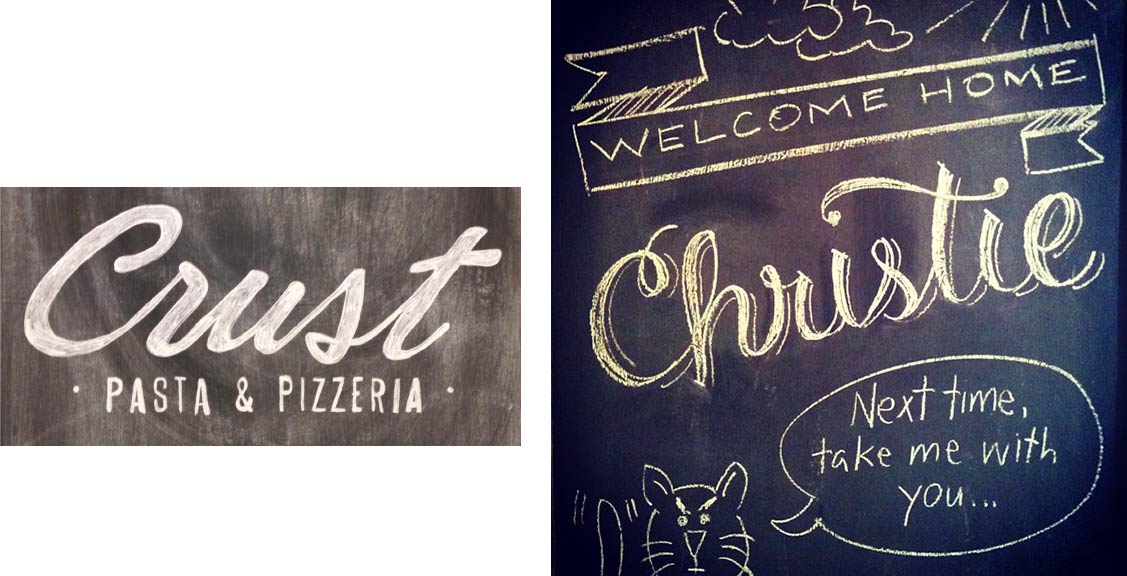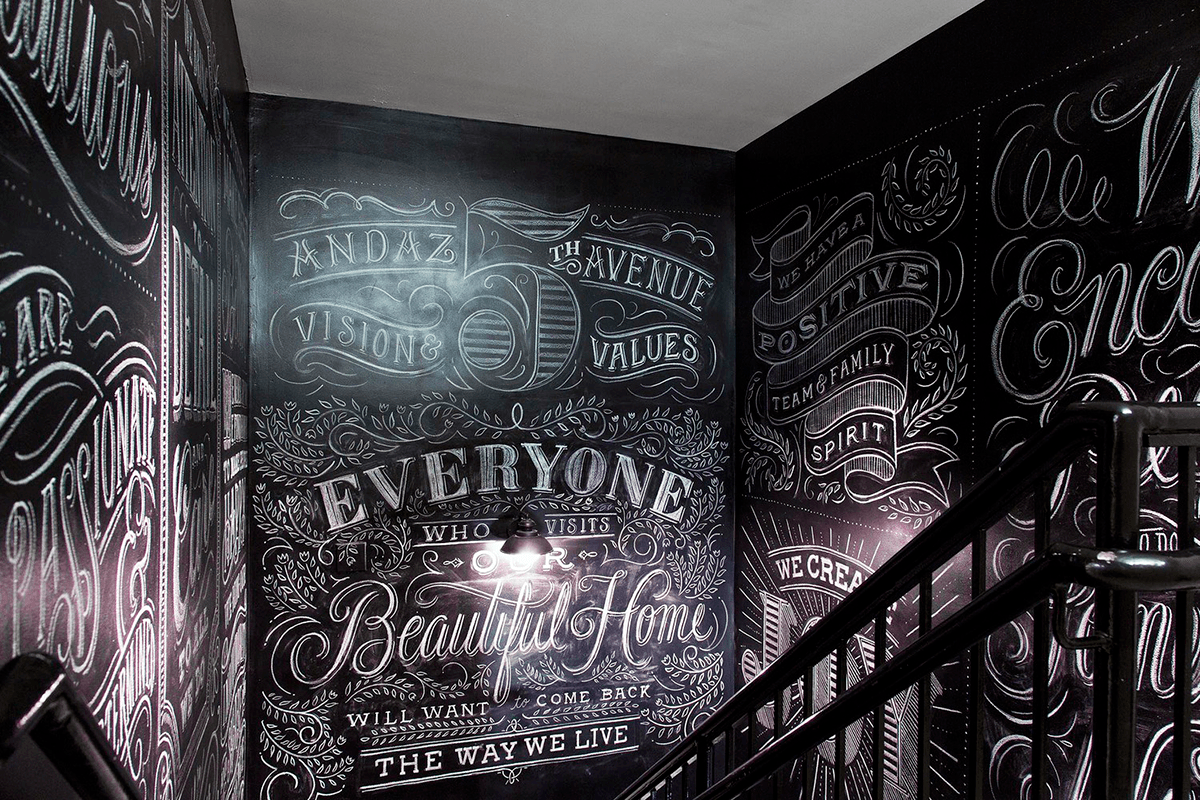Chalk Lettering, a Return to Low Tech

One of the most charming trends to hit graphic design and typographic solutions in the recent past is chalk lettering. With so many aspects of modern life dependent upon and reflective of high tech and digital solutions, the return to more organic, handmade techniques has become a very fashionable approach. It is an extension of the popularity of all things retro, which includes fonts such as those designed by House Industries, a foundry that has made its name from retro typeface revivals. In fact, the attraction to all things vintage has become a sought-after approach for many, especially (we) baby boomers who long for the warmth and comfort of earlier days.
When commercial chalk lettering started appearing, it was primarily used by cafés and restaurants, farmer’s markets, store fronts, and other casual usage. But over time, it has become a solution for all things from advertisements to magazines and book covers, signage and logos, wall hangings, invitations, labels and place settings, and even on fabric and clothing!

The addition of charming color illustrations enhances this piece. Artist unknown.

The homey feel of chalk lettering works well for restaurant and café menus. By Nate Williams.

Gail Brill created a total wedding identity for a lucky couple, from a ‘Save the Date’ mailing to parking signage.

Chalk lettering is used for both a professional logo by Atlanta sign artist Katie Bush, to an informal ‘welcome home’ sign by Christopher Rouleau.
Chalk lettering has few rules or boundaries: it can be done in b&w or color, print or cursive, be informal and homemade-looking or be very precise, as well as combining styles in numbers that would be unacceptable in traditional typography. The object is to create a unique, one-of-a kind solution that conveys a mood and feeling of warmth and friendliness through the overall look of the lettering, as well as the meaning of the words.
At the onset of this trend, this kind of chalk work was done by professionals who transferred their traditional lettering skills to this medium. But eventually, others – both designers and laypeople with a flair for lettering and calligraphy (or just an interest) – have attempted it themselves. Once this happened, a glut of how-to books, videos, and on-demand webinars became available to fuel this interest. This was in addition to the trickle of fonts that mimicked this style, as fonts always seem to do with lettering trends.
The Start of It All
One of the earliest pioneers of this expressive medium is Dana Tanamachi. Dana is a lettering artist and designer who came upon her newfound notoriety per chance. In 2009, an impromptu chalk installation for a Brooklyn housewarming party landed Dana her first commission for Google, and set the popular chalk-lettering trend – and her career – in motion.

Dana Tamanachi in front of her chalk mural for Oprah’s O You Conference

A printed poster from Tanamachi Goods.
After working under design icon Louise Fili, she opened Tanamachi Studio, a boutique design studio specializing in custom typography and illustration for editorial, lifestyle, food, and fashion brands. Due to the widespread popularity of this genre, Dana has been commissioned globally by clients such as Nike, USPS, Penguin Books, Ralph Lauren, Tommy Hilfiger, and West Elm, as well as having the distinct honor of creating custom chalk cover art for O, HOW, and TIME Magazines.
Eventually, others caught on to this trend, with it spreading to other designers, letterers, calligraphers, and anyone interested in trying their hand at this technique. 


Both murals and wine labels by Dana Tamanachi for Nagging Doubt wines

Three adjoining walls of chalk murals surround a staircase at the Andaz Hotel in New York, by Dana Tanamachi.



Dana’s work has spread to book covers, magazine covers, and even snowboards!
Tutorials, Fonts, and Other Resources
There are several options when you want chalk lettering for a job or project. They are: hire a pro, use fonts, or do-it-yourself, all of which we will discuss. Some people use apps such as Procreate App for iPad, and software such as Photoshop to create this effect digitally. Due to the popularity of chalk lettering and illustration, there are now numerous how-to videos and tutorials (as mentioned earlier), books, and even chalk lettering templates for invitations, menu boards, and other media that lend themselves to this trendy treatment. 
Two of the most popular online classes to learn chalk lettering are found on the CreativeLive and Skillshare websites. Annica Lydenberg’s Chalk Lettering webinar will take you through the process of completing a large scale installation as she makes a chalk mural onsite at CreativeLive’s San Francisco headquarters. You’ll learn the many ways to turn a small sketch or something you designed on the computer into a piece on a wall. Watch this mural come to life and learn the techniques and process that go into making one.

Learn Chalk Lettering from Annica Lydenberg on CreativeLive

Images from a calendar by Annica Lydenberg.
Lauren Hom’s Hand Lettering for Chalk Murals class is another good choice. It is all about creating large-scale lettering art by hand. By the end of this fun 40-minute class on bringing chalk murals to life, you’ll be able to convert a small notebook sketch to a large-scale lettered piece.

Lauren Hom offers a tutorial webinar on Chalk Lettering on Skillshare.

Hom (shown above) decorates her wall with help from Cristina Pagnocelli.
If you want to use chalk lettering fonts, there are many to be found. Just remember to think like a lettering artist and pay close attention to the layout. As for books, here are two of many to choose from: The Complete Book of Chalk Lettering: Create and Develop Your Own Style, by Valerie McKeehan, and The Big Awesome Book of Hand & Chalk Lettering, by Dina Rodriguez.

Two lists of chalk fonts.
Is all this exposure diluting the popularity and appeal of this technique? Not in my book, at least not yet…no moreso than calligraphy, sign painting, or any other hand-drawn creations. So if chalk lettering appeals to you for any kind of project, give it a go!

A good rule of thumb by Skyler Chubak.
This article was last modified on October 22, 2018
This article was first published on October 22, 2018



